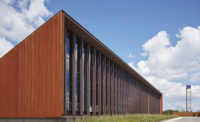After languishing for years outside the mainstream, "switchable glazing" is poised to become a viable alternative and could soon have a significant impact on facade design.
Two other types of switchable glazing are called liquid crystal device windows and suspended particle device windows (SPD). Liquid crystal technology has been used for some time in wristwatches and is gaining popularity as privacy glazing. A thin layer of liquid crystals is sandwiched between two transparent electrical conductors on thin plastic films, and the entire device is laminated between two layers of glass. When power is off, the liquid crystals are in a random and unaligned state. They scatter light, which makes the glass become translucent, thus obscuring direct views and providing privacy. This type is used most often in interior applications, including bathrooms, conference rooms, and changing rooms in retail stores.
SPDs, on the other hand, start out dark and become transparent when voltage is applied. They are made of an electrically controlled film with a thin, liquidlike layer in which molecular particles are suspended between sheets of glass. When electricity comes into contact with the SPDs, which have a transparent conductive coating, they line up in a straight line and allow light to flow through. Once the electricity is turned off, they move back into a random pattern and block light.
While “smart glass” technologies promise to make huge contributions to efficiency, they are poised to have a tremendous impact architecturally on facade design. Most research focuses on the impact of switchable glazing on interiors because the goal is to control daylighting and heat gain. But what about the effect on a building’s exterior, especially on the rhythm of fenestration, the architectural scale, and proportion? Switchability will make these elements fluid and certainly change perception.
Because the use of “smart glass” is not yet widespread, the impact on design has not begun to receive much investigation. However, an experiment in the area of adaptive building envelopes is under way at structural engineer and professor Werner Sobek’s Laboratory at the Institute for Lightweight Structures and Conceptual Design at the University of Stuttgart, Germany. Of particular interest is a project called R129. “The goal of this project is to create a structure that will give the inhabitants direct contact with the surrounding nature, but still protect them from the elements,” explains Sobek engineer, Frank Heinlein.
The building envelope is to be made of the switchable glass lites, plus a very thin layer of Plexiglas that provides antiscratch protection and has a low-E coating. These switchable lites consist of various layers, including an electrochromic foil. The foil allows the entire envelope to be darkened or made completely opaque, either in sections or as a whole. Adaptability is mainly achieved by means of the liquid crystal embedded within the glass panes, two polarization filters, and transparent electrodes. Different from other switchable-glazing product developments, this patent-pending technology allows light transmission to be varied, colorless, and quick to change.
The structural frame is fabricated from carbon box sections. The foundation is a carbon “raft,” which carries a radiant-heated floor, HVAC equipment, storage, and IT functions. There are no fixed interior partitions or walls between the various functional areas. A central nonstationary module houses bathroom and kitchen installations.
The biggest concern at the moment in all R&D is durability. NREL has been testing electrochromic devices in accordance with ASTM standard E-2141 (Standard Test Methods for Assessing the Durability of Absorptive Electrochromic Coatings on Sealed Insulating Glass Units). The lab reports that at least one manufacturer has produced a ceramic, thin-film electrochromic device that has shown excellent durability under test conditions.
According to ToolBase Services (toolbase.org), the housing industry’s resource for technical information about building products, materials, and new technologies, the cost of electrochromic windows can be from two to three times more than a standard window. Comparing the two is not particularly useful, though, because the equation doesn’t take into account the energy savings from electrochromic insulated glass units. If electrochromic devices perform better, then a building can be equipped with smaller, and therefore less expensive, HVAC systems. At any rate, costs are expected to decrease significantly when manufacturing techniques improve and sales increase. Meanwhile, manufacturers are fine-tuning their control systems and exploring other means of powering the “smart glass.”


Joe-Fletcher.jpg?height=200&t=1719286630&width=200)
